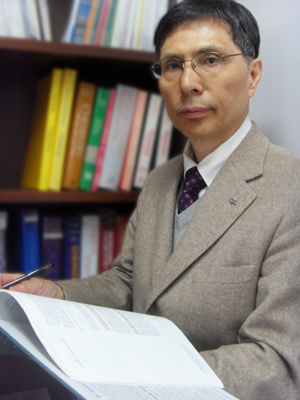
On Thursday, December 15, 2016, Prof. Kwang S. Kim from the Ulsan National Institute of Science and Technology (UNIST) in Korea will visit DCMS and give a Seminar Presentation (at 13:00 in the Seminar Room in Hallwachsstraße 3) titled “High-Performance Computing and Multi-Scale Simulations: Predictions for Excited Electrons and Ultrafast Electron-Ion Dynamics in Complex Materials”.
Kwang S. Kim is currently a Professor of chemistry, an Adjunct Professor in physics, and the Director of the Center for Superfunctional Materials of Ulsan National Institute of Science and Technology (UNIST) in South Korea. He received his B.S. and M.S. degrees in applied chemistry from Seoul National University and another M.S. degree in physics from Korea Advanced Institute of Science and Technology. He obtained his Ph.D. degree from the University of California, Berkeley. He spent a few years as an IBM Postdoctoral Fellow and as a Research Assistant Professor at Rutgers University. He joined POSTECH in 1988 (until Feb. 2014, Professor, POSTECH Fellow). He is a Fellow of the Korea Academy of Science and Technology. He is a Senior Editor of the Journal of Physical Chemistry A, B, C (Am. Chem. Soc.). He has been an Editorial Board Member of various journals including NPG Asia Materials (Nature Publishing Group), Wiley Interdisciplinary Reviews: Computational Molecular Science (Wiley), Chemistry Letters (Chem. Soc. Japan), Journal of Computational Chemistry (Wiley-VCH), Chemistry – An Asian Journal (Wiley-VCH), and Computational and Theoretical Chemistry (Elsevier). He has been a Conference Board Member of the World Association of Theoretically Oriented Chemistry and the Asian Pacific Association of Theoretical and Computational Chemistry. His fields of research include investigations of density functional theory, ab initio calculations, nonequilibrium Green function theory, Monte Carlo and molecular dynamics simulations, first principles ground and excited-state molecular dynamics simulations, intermolecular interactions, clusters, molecular recognition, receptors, drug design, bioinformatics, biomolecules, nanomaterials, molecular devices, spintronics, and quantum computing.
Extended Abstract:
The success of novel molecular and material design depends on a comprehensive understanding of inherent atomic/molecular properties, interatomic/molecular interactions, and dynamic/transport properties of molecular/material systems [1,2]. Here I elaborate on the interplay between theory and experiment to design superfunctional carbon-based nanomaterials and nanodevices. These include intriguing organic nanostructures, large-scale graphene [3], and functionalized carbon hybrid materials for energy harvesting, fuel cells, gas storage, water remediation, and medical treatment. Assembling phenomena of diverse nanostructures and utilization of the resulting unusual functional characteristics as devices are addressed. Selective sensing of fullerenes [4] and fluorescence-sensing of RNA over DNA [5] are achieved with π+-π, π-π interactions and charged hydrogen boning. The temperature-driven transient molecular gating in covalent organic molecular frames can store gaseous molecules in ordered arrays toward unique collective properties [6]. Using self-assembled nano-scale lenses, hyper-resolution phenomena showing near-field focusing and magnification beyond the diffraction limit are manifested [7]. Intriguing nanophotonics phenomena is also addressed [8]. I will also elaborate on a recent development of Pt nanoclusters and nanodendrites in a genomic-double-stranded-DNA/reduced-graphene-oxide [9]. Compared to state-of-the-art catalysts, the as-synthesized hybrid materials display outstanding catalytic activities toward the oxygen reduction reaction (ORR). Moreover, the hybrid exhibited a constant mass activity for the ORR over a wide pH range 1-13. Super-paramagnetisim was exploited to remediate water with magnetite in graphene [10]. I also discuss electron/spin transport phenomena in molecular electronic/spintronic devices and super-magnetoresistance of graphene nanoribbon spin valves using non-equilibrium Green function theory plugged in density functional theory [11]. By utilizing Fano-resonance driven 2-dimensional molecular electronics spectroscopy using graphene nanoribbon, the hyper-sensitive quantum conductance spectra of a graphene nanoribbon placed across a fluidic nanochannel can lead to fast DNA sequencing including cancerous methylated nucleobases detection [12,13]. Along with this line, the development of attosecond spectroscopy to detect electronic motions in attosecond timescale is addressed [14]. Finally, collective properties of liquids and solids are discussed based on ab initio many body molecular dynamics simulations. Phase transitions of materials and the limits of superheating and supercooling of vapor are studied with Monte Carlo simulations using microscopic models with configurational enthalpy as the order parameter [15] so that water can be harvested in dry and hot conditions.
[1] Y. Cho et al. Acc. Chem. Res. 2014, 47, 3321.
[2] V Georgakilas et al. Chem. Rev. 2012, 112, 6156; 2016, 16, 5464.
[3] K. S. Kim et al. Nature 2009, 457, 706; S. Bae et al. Nature Nanotechnol. 2010, 5, 574.
[4] Y Chun et al. Nature Commun. 2013, 4, 1797.
[5] B. Shirinfar, et al. J. Am. Chem. Soc. 2013, 135, 90.
[6] S. B. Baeck et al. Proc Natl Acad Sci. 2015, 112, 14156.
[7] J. Y. Lee et al. Nature 2009, 460, 498.
[8] D. R. Mason et al. Opt Lett. 2010, 35, 2007.
[9] J. N. Tiwari et al. Nature Commun. 2013, 4, 2221.
[10] V. Chandra et al. ACS Nano 2010, 4, 3979.
[11] W. Y. Kim et al. Nature Nanotechnol. 2008, 3, 408.
[12] S. K. Min et al. Nature Nanotechnol. 2011, 6, 162.
[13] A. C. Rajan et al. ACS Nano 2014, 8, 1827.
[14] S. K. Min et al. J. Chem. Phys. 2011, 135, 244112; Phys. Rev. Lett. 2014, 113, 263004.
[15] W. J. Cho et al. Phys. Rev. Lett. 2014, 112, 157802.



